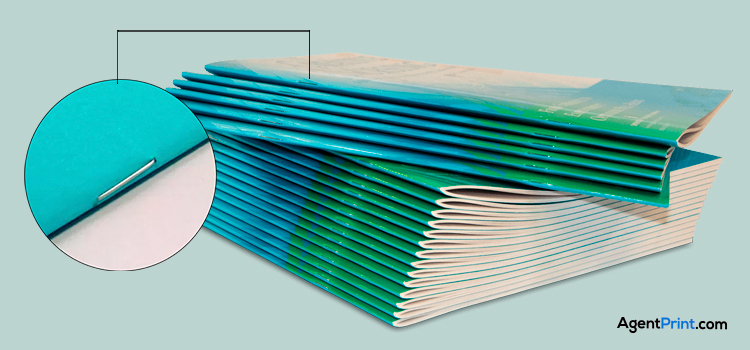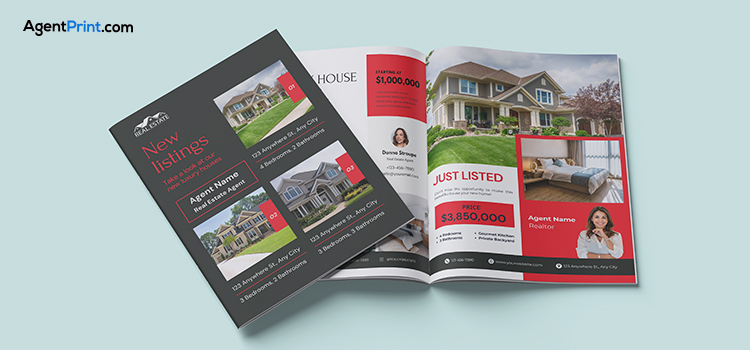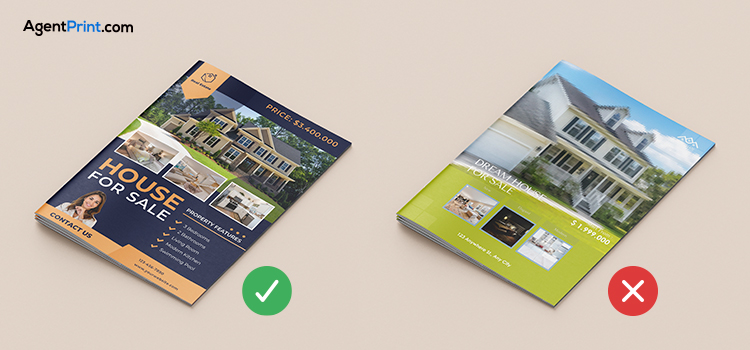One impressive way to introduce your real estate business to new clients is to use booklets. For real estate agents, especially, this format could be useful for representing their brand’s professionalism and achieving different marketing purposes. Crafting a compelling real estate booklet design requires some important hints to follow so you can properly achieve your goals. In this guide, we are going to show you the path to creating a professional-looking booklet, mentioning the most important design tips.
Why Booklet Design Matters for Real Estate Marketing
Offering engaging visuals and detailed information about a property for open house announcements or new projects requires marketing material bigger than a flyer. Booklets have dozens of pages and are often more portable and user-friendly. The way you design your real estate booklets is crucial to capturing your clients’ attention. Here is why:
- First Impressions: To change a hypothetical client into a loyal customer, the first impression of the booklet is very important. How you present the details shows the customer how detail-oriented and organized you are.
- Showcasing the Property: Booklets can offer enough space to contain all the property descriptions, high-quality photos, key selling points, and contact info.
- Telling Your Story: Every property has its story and history. You can highlight its unique story in a booklet, which is a useful method to show the differentiation.
- Winning the Competition: Real estate agents can use booklets to differentiate their services from their rivals and develop strong connections with possible customers.
- Lead Generation: Distributing professional-looking booklets in the determined area will exactly target the possible clients and lead them to take action.
- Branding Goals: A well-structured booklet can effectively build trust with potential clients and maximize brand awareness in specific neighbourhoods.
- Reference: The printed booklets play an important role in being a good reference material for clients’ further comparison or a source of information.
Read more: 4 Great Benefits of Property Booklets that Make Them Marketing Favourites
Key Elements of a Professional Booklet

Booklets are more than a colourful printed element; they are a vital marketing item. To create the best booklet design and layout for your business, you must consider a few tips, including:
- Set your goals. While using a random template for your booklet is simple, it lacks impact. You should design your booklet individually based on your own preferences and marketing goals.
- Know your audience. Before you start designing, think about what your clients are looking for and what their wants and needs are.
- Find an appropriate size and layout. Each booklet size and format has a unique purpose that works best for it. Find out which one works best for you!
- Readability is key. Keep it brief, avoid technical language, speak simply, and get to the point. Over-talking will be boring for the reader!
- Use sharp images. Using authentic, high-quality photographs of the neighbourhood and property has unique value. High-resolution, relevant photos can significantly enhance the compelling design and help the storytelling.
- A charming cover adds value. The good first impression depends on the cover page of your booklet. For introducing your business, a well-designed layout and brand-related fonts and colours are crucial.
Choosing the Right Size and Layout for Your Booklet

There are several standard sizes for printing booklets; each of them has different applications. Let’s review the most popular ones:
| Size | Overview |
9 x 12 inches | This format, known as the magazine’s standard size, is the popular choice for gorgeous art publications. So, it offers you enough space for all the visual and textual content, with the desired layout you have in mind. |
8.5 x 11 inches | Known as US Letter Standard, it is the most commonly used for documents, such as manuscripts and reports, offering enjoyable readability. |
4.25 x 11 inches | The special slim format of this size can easily catch the reader’s attention because of its sharp design. There is no doubt that such a distinct shape can enhance brand recognition and remain in customers’ minds. |
6 x 9 inches | The high readability of this dimension, which is known as the standard novel size, offers an ideal reading experience. By reminding us of the size of classic books, these booklets also offer comfortable portability. Real estate agents can perfectly use it for events and guidebooks. |
8.5 x 8.5 inches/8 x 8 inches | The square shape of this format may not be so popular for booklets, but they are an ideal choice for making a difference. Its layout and space are enough to properly contain the logo, contact info, and attractive images. |
4.25 x 5.5 inches | Known as pocket-sized booklets, these are definitely compact, more affordable, and easy to carry. This mini format is a good size for promoting the next event or offering a distinguishable service. |
A4 | Its standard international size is 8.27 x 11.69 inches, and it is well known in different documents. They are easy to assemble and also have a consistent layout and enough space to address the new listings for real estate booklets. |
A5 | This cute standard compact size is 5.83 x 8.27 inches, and it is optimal for educational content, short tips, and advertising. Despite its small size (exactly half of A4), it still has ample space for your visual and textual content, plus other valuable information. |
Choosing the Best Booklet Bindings

There are many different types of booklet bindings you can choose from. Some of them are more popular for specific activities/events, and others have their unique application. Here is a quick review of different booklet binding methods:
- Saddle-Stitch: This binding approach requires paper sheets to be folded in half before stapling the spine area. This method produces a straightforward, cost-efficient binding solution for smaller booklets.
- Perfect Binding: In this approach, the pages receive a glue application on their spine to form a squared-off edge. Those who desire a professional appearance and lasting durability for thicker publications can choose this binding option.
- Spiral Binding: The pages get hole-punched across their edges before a wire or plastic spool binds all pieces. The flexible layout of books with spiral bindings matches the needs of manuals and workbooks.
- Wire-O Binding: The double-wire design of this method creates a tough and flat binding mechanism similar to spiral binding. You can use it for important documents to protect them with such a durable structure.
- Comb Binding: Pages connect through punched holes that receive a plastic comb inserted along the document’s edge.
- Tape Binding: The edges of documents become bound together with adhesive tape. This is a cost-effective method for thinner booklets.
- Hardcover or Case Binding: This binding method produces a sturdy booklet by attaching pages through sewing to a rigid cover.
The above-mentioned methods are the most popular ones for booklets. There are also Japanese stab binding and screw binding, which offer distinctive visual features and operational capabilities.
Tips for Creating Engaging Content
Booklet effectiveness depends on its content because it determines whether the desired message reaches its audience and meets the intended purpose. A booklet reaches its target audience when it combines relevant material that attracts attention throughout its lifetime. The following points explain the importance of content:
1. Your Marketing Goal:
The main objective of the booklet deserves corresponding content. A marketing booklet will emphasize product features and benefits, while an educational booklet delivers information. Careful definition of the booklet’s mission produces a well-directed content stream that generates stronger outcomes.
2. Focus on Audience:
The content needs to address the particular needs and preferences of those who will use it. Understand audience needs by examining their knowledge level and language preference. Identify their desired information and build content from an audience perspective.
3. Clear Message:
Keep specialized vocabulary out of your content since it may create confusion among readers. Utilize straightforward language while breaking text into segments with headings, bullet points, and subheadings. Follow a logical arrangement that directs readers through the desired path.
4. Visual Communication:
The use of images, charts, and graphs improves both visibility and engagement of your content. Your points should have supporting examples that take the form of case studies, real-life stories, and real-world examples.
5. Call to Action:
A booklet that wants readers to take particular actions must include straightforward instructions to complete the desired initiative. The content requests readers to either obtain further information or make purchases. You can build a fully functional booklet when you focus on content excellence. This allows for visual attractiveness and audience engagement throughout the material. For the best result, you can use the printing services of AgentPrint.com for all your real estate marketing tools.
Common Mistakes to Avoid in Booklet Design
A booklet loses its effectiveness when design standards fall below quality criteria. Your booklet design needs to be eye-catching with clear content and audience engagement. Clarity gets lost when a booklet presents excessive content for multiple target audiences. Low-quality pictures lead to visual confusion and an unattractive appearance. The absence of contact details and poor call to action prevent potential customers from moving forward in the sales sequence. Bad binding and poor paper quality also give booklets a bad look, which will drive away possible clients.
Printing Considerations for a Professional Finish
The combination of an appropriate file format, good resolution, attractive colour selection, and proper paper type ensures professional results. This requires post-printing finishing and quality control procedures for successful execution. For ideal results, consider the following tips:
- Resolution: The vector file formats SVG and PDF work best for printing because they enable perfect sharpness throughout all size scales. A resolution of at least 300 DPI in a print-ready file delivers maximum image clarity while ensuring high print quality.
- Colour: Printing professionals use CMYK colour mode because it delivers precise colour representation.
- Paper and quality: Select from either matte or glossy paper stock according to project requirements. Check the contrast and quality of files and colours before printing.
Final Words
Booklets are useful and attractive marketing tools for different businesses and various activities. You can use them for a detailed event invitation or product introduction. Your professional booklet serves as an investment for your brand identity and audience loyalty. The foundation of successful booklet design includes both careful planning and detailed layout. So, follow these top design principles to transform your booklet into a united and visually stunning communication element.

